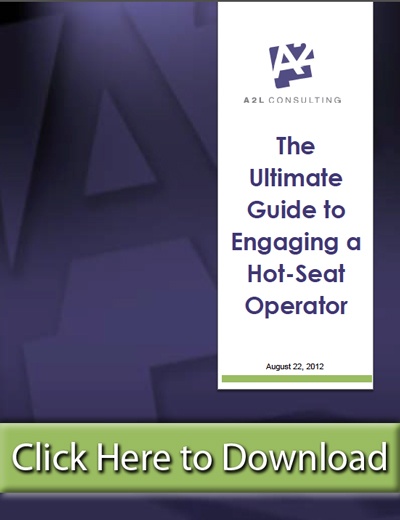 by Ken Lopez
by Ken Lopez
Founder/CEO
A2L Consulting
Part 2 of a four-part series on the rise of the midsize law firm in litigation. Parts 1,2,3,4.
A few months ago, Inside Counsel reported that midsize law firms with 201-500 lawyers had doubled the amount of litigation generating more than $1 million in legal fees over the past three years. We see this trend taking hold as well with more and more firms in this range utilizing our litigation consulting services.
In my last article directed at midsized law firms handling large-scale litigation, I discussed what litigators at those firms should know about litigation graphics. In this second of four articles, I want to cover one of my favorite topics -- the use of trial technicians, sometimes called hot-seaters. Many litigators at midsize law firm litigators have never used a trial technician, and it is not a decision that should be made without some background on the field.
It was not that long ago that we used laser discs and bar codes to display documents and deposition clips at trial. That old-style technology has evolved considerably, but it is still essentially the same.
In a document-intensive case, it is important for the litigator to have the ability to make available, instantly, any one of millions of documents, demonstratives or deposition clips. Preparing a system to make this possible and running it at trial is the job of a trial technician. It is not easy, and it is generally not something one should do in-house in a big case.
Here are eight tips related to using trial technicians:
1) Download this book on selecting and using a trial technician: Like all of the litigation books on our site, it is free and full of useful information.
2) Understand the problem you are solving: In the modern courtroom, you can lose all your credibility by fumbling with technology. When you are trying a big case, you are the conductor, and the evidence is your orchestra. Among other things, it is your job to conduct and manage the work of the trial technician. Here is a good example of a trial technician at work: Making Good Use of Trial Director & Demonstratives in an Arbitration.
3) Price is an important consideration, but it is far from the most important: The skill of trial technicians varies as widely as the skill of musicians. If you have the wrong person running your show, you will look bad and your case will suffer. This article on trial technician pricing and cost goes into more detail.
4) Consider how you will use deposition video at trial: I like this article on our site for this purpose: 6 Tips for Effectively Using Video Depositions at Trial.
5) Practice, practice, practice: When the relationship and preparations are right, a trial technician appears to be able to anticipate the next moves of lead counsel. This is only possible with practice. Good practice for litigation looks like this and and the results of good practice for trial look like this.
6) No, there is probably not a world-class trial technician in your town: There are only a handful of talented trial technicians around the country. Nine times out of ten, you will have to import them - even in Manhattan. One of the biggest mistakes I see is a trial team trying to avoid the small cost of a hotel room for a trial technician. After all, they are probably going to be spending plenty of late nights with you anyway.
7) If they are not using Trial Director, watch out: There is a reason that this software product has about 90 percent market share. It works, and if something goes wrong, you have a way to fix it.
8) Survey your courtroom: Good trial technicians insist that a survey of the courtroom be conducted early enough to plan for the best possible display of evidence.
Parts 1,2,3,4.
Other articles on A2L's site related to trial technicians and hot-seaters:
- What is the cost and pricing for a trial technician?
- 7 things you never want to say in court
- Will being low-tech help you relate better to your jury?
- What painful trial technology failures look like in real life
- 12 ways to avoid a trial technology failure
- Part 1 of this series - 16 Litigation Graphics Lessons for Mid-Sized Law Firms






Leave a Comment